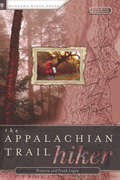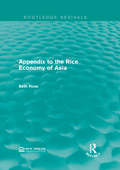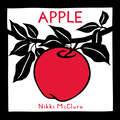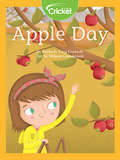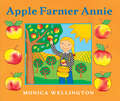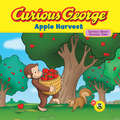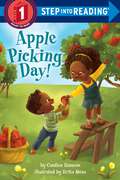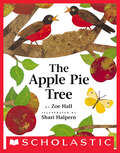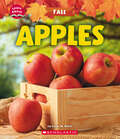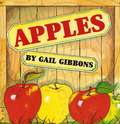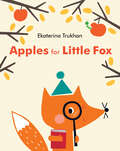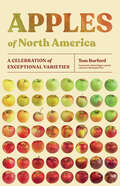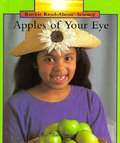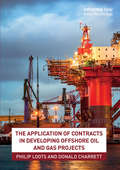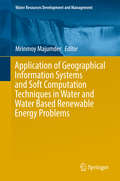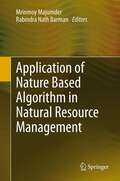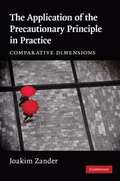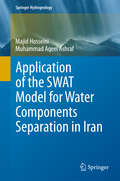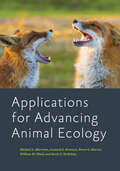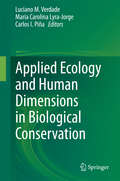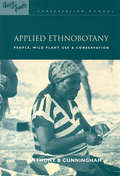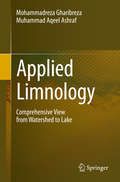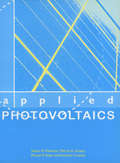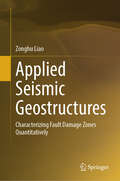- Table View
- List View
The Appalachian Trail Hiker
by Frank Logue Victoria LogueThe Appalachian Trail Hiker is a one-stop guide to preparing for and hiking the A.T. Although primarily geared to prepare and sustain the intrepid thru hiker, the book is also a must-have for anyone who wishes to experience the A.T., whether for an hour or for six months.
Appendix to the Rice Economy of Asia (Routledge Revivals)
by Beth RoseOriginally published in 1985, Beth Rose’s Appendix to the Rice Economy of Asia provides twenty-six tables detailing various rice statistics across Asia from the beginning of the twentieth century through to the 1980’s. Statistics presented include; total crop area, rice production and yield, import and export, rice prices, farm wages and populations of countries or areas within Asia. This title will be of interest to students of Environmental Studies and Economics.
Apple
by Nikki McClureApple follows the life of an apple throughout the year, demonstrating the cyclical patterns in nature. The youngest readers will delight in following the journey of the bright red apple—the only splash of color in the otherwise black-and-white illustrations—as it travels from tree, to harvest, to snack, to compost, and finally to sprout. A single word complements each illustration, urging early readers to reflect on each stage in the apple’s life. Apple is acclaimed cut-paper artist Nikki McClure’s very first book, originally self-published and sold in a limited edition of just 200 copies. Now, 16 years later, it is available in wide release, and fans will relish the chance to own the book that launched McClure’s signature style.
Apple Day
by Kimberly Long CockroftLong ago, when the mountains looked down on a bare, quiet valley, Molly's grandparents planted tiny saplings in a newly cleared field. Now Molly and her cousin Sam pick apples from the orchard to make blue-ribbon applesauce! Recipe Included.
Apple Farmer Annie Board Book
by Monica WellingtonA new format for a yummy fall favorite Filled with bright primary colors and pictures of America's favorite fruit, Wellington's enticing story follows Annie, a busy apple farmer. She picks, counts, sorts, bakes tasty treats, and sells her best apples. Already successful in hardcover and paperback, Apple Farmer Annie in board book format is one that young tots will find absolutely irresistible.
Apple Harvest (Curious George)
by Lynne PolvinoWhile helping the Renkinses harvest their apples, George discovers a giant cider press inside the barn! As usual, George’s curiosity gets the best of him, and he accidentally starts the machine. Suddenly all of the apples they’ve collected are being washed, chopped, and squished into liquid! Will George be able to collect the cider and stop the machine, or will he find himself in an even stickier situation?
Apple Picking Day! (Step into Reading)
by Candice RansomWho doesn&’t love to go apple picking at the first sign of fall? A sister and brother celebrate autumn with a trip to a local apple orchard in this simple, rhyming Step 1 early reader. The kids bound with glee through the rows of trees, and race against other children to pick the most and the best apples. The story of their day is bright, fun, and full of light action. It&’s told in easy-to-follow rhyme, ensuring a successful reading experience. Step 1 Readers feature big type and easy words. Rhymes and rhythmic text paired with picture clues help children decode the story. These books are for children who know the alphabet and are eager to begin reading.
The Apple Pie Tree
by Zoe HallWe have a special tree in our yard -- an apple pie tree!Colorful collage illustrations follow each season as an apple tree grows leaves, fragrant blossoms, and tiny green apples. Soon the fruit is big, red, and ready to be picked. It's time to make an apple pie! Here is a celebration of apples and how things grow -- sure to delight young readers all year long.
Apples (Learn About)
by Sonia W. BlackLet's learn all about the most important symbols and celebrations of the fall season!It wouldn't be the fall season without crisp and juicy apples! With vibrant photos and lively text, this book explores how apples are grown, picked, and baked into treats. Get ready to learn all about apples in fall!ABOUT THE SERIES: Fall is here and so are colorful leaves, delicious apples, orange pumpkins, and lots of celebrations! With this new series, dive into the icons that make fall so much fun. Why do we harvest apples in fall? How does a pumpkin grow? Why do leaves change color? What holidays are in fall? With gorgeous photographs and simple text, this is a celebratory exploration of the fall season.
Apples
by Gail GibbonsExplains how apples were brought to America, how they grow, their traditional uses and cultural significance, and some of the varieties grown. Also discusses how to care for an apple tree and gives a recipe for Apple Pie. Good book for anyone curious about this classic fruit.
Apples for Little Fox
by Ekaterina TrukhanAs Fox investigates the mystery of the missing apples, kids can follow along and solve the mystery on their own! Perfect for fans of Lucy Ladybug and Hey, Duck!Fox loves to read mysteries—he wants to be a detective someday! He goes to the library every morning and collects delicious apples to eat on his way home. But one day, all the apples are missing! What could have happened to them? Fox is so excited to crack his first case. Follow along as he searches for clues and discovers a BIG surprise! In this charming story from newcomer Ekaterina Trukhan, her fresh illustrations draw us into the little world of Fox and his friends.
Apples of North America: A Celebration of Exceptional Varieties
by Tom Burford&“For all of us who cherish the apple, its utility, its flavors, and its powers of revelation and connection.&” —Adrian Higgins, garden columnist, The Washington Post The apple is one of the most iconic fruits, traditionally picked on cool fall days and used in pies, crisps, ciders, and more. And there is a vast world of varieties that goes well beyond the common grocery store offerings. With names like American Beauty, Carter&’s Blue, and Fallawater, and flavors ranging from sweet to tart, this treasure trove of unique apples is ripe for discovery. There is no better guide through this tasty world than Tom Burford, whose family has grown apples in the Blue Ridge Mountains since 1715. His celebratory book Apples of North America is brimming with beautiful portraits of heirloom and modern apples of merit, each accompanied by distinguishing characteristics and common uses. You will also find information on growing apples at home—with specifics on planting, pruning, grafting, and more—and instructions on how to preserve apples through pressing, fermenting, cooking, and drying.
Apples of Your Eye
by Allan FowlerDescribes all of the wonderful food you can make from the different varieties of apples.
The Application of Contracts in Developing Offshore Oil and Gas Projects
by Philip Loots Donald CharrettThis book provides a comprehensive overview of the key aspects and contracts involved in the process of developing oil and gas projects, with an emphasis on offshore developments. Project development in oil and gas carries with it numerous unique risks and challenges. By identifying and managing risk through the various contract stages, each stage of the project is seen in perspective and therefore gives readers a better understanding of how that stage was arrived at and what is expected to come later. To do this, the authors use illustrative international case studies from past and current projects, thereby deepening the reader’s understanding and awareness of risk from practical experience, as well as suggesting answers for those who are involved in developing oil and gas projects. The Application of Contracts in Developing Offshore Oil and Gas Projects is intended for project owners, project managers, contractors, finance managers, commercial managers and lawyers who seek to understand the subject from a practical point of view.
Application of Geographical Information Systems and Soft Computation Techniques in Water and Water Based Renewable Energy Problems (Water Resources Development and Management)
by Mrinmoy MajumderThis book highlights the application of Geographical Information System (GIS) and nature based algorithms to solve the problems of water and water based renewable energy resources. The irregularity in availability of resources and inefficiency in utilization of the available resources has reduced the potentiality of water and water based renewable energy resources. In recent years various soft computation methods (SCM) along with GIS were adopted to solve critical problems. The book collects various studies where many SCMs were used along with GIS to provide a solution for optimal utilization of natural resources for satisfying the basic needs of the population as well as fulfilling their burgeoning energy demands. The articles depict innovative application of soft computation techniques to identify the root cause and to mitigate the uncertainty for optimal utilization of the available water resources. The advantage of SCM and GIS were used to maximize the utilization of water resources under cost and time constraints in face of climatic abnormalities and effect of rapid urbanization.
Application of Nature Based Algorithm in Natural Resource Management
by Mrinmoy Majumder Rabindra Nath BarmanThis book highlights the application of nature-based algorithms in natural resource management. The book includes the methodologies to apply what natural flora or fauna do to optimize their survival. The same technique was used to optimize renewable energy generation from water resources, maximization of profit from crop harvesting, forest resource management and decision-making studies. These studies can be used as an example for finding solutions of the other maximization or minimization problems which are common in natural resource management.
The Application of the Precautionary Principle in Practice
by Joakim ZanderThis overview of the role played by the precautionary principle in international trade law, European law and national law compares how precautionary considerations have been applied in the fields of pesticide regulation and the regulation of base stations for mobile telephones in Sweden, the UK and the US. A number of problems in the current application of the precautionary principle are identified and discussed. For example, it is shown that a firm reliance on a wide and open-ended precautionary principle may lead to problems with the consistency, foreseeability, effectiveness and efficiency of measures intended to reduce environmental or health risks. It is suggested that the precautionary principle indeed may be an important tool, but that in order to be acceptable it must be coupled with strong requirements on the performance of risk assessments, cost/benefit analyses and risk trade-off analyses.
Application of the SWAT Model for Water Components Separation in Iran (Springer Hydrogeology)
by Majid Hosseini Muhammad Aqeel AshrafWater balance studies for large and small river basins are the subject of this book. Here, the specific focus is on the soil and water assessment tools (SWAT) model coupled with geographic information system (GIS) remote sensing data for a comprehensive study. Some books available in the market provide an overview of different hydrological models for water balance but not specifically for the SWAT model. This book effectively utilizes the SWAT model to study the water balances in small and large catchments with consistent competence and excellent accuracy for yearly and monthly water balance modules along with suspended sediment yield over several slope classes of the catchments. The approach is new and has been successfully utilized, as discussed in a case study on the Taleghan Catchment in Iran. These implementation models may assist as advantageous techniques for incorporated management of catchments in the direction of sustainable development. This book will help readers who wish to study all the changes related to those in water balances.
Applications for Advancing Animal Ecology (Wildlife Management and Conservation)
by Michael L. Morrison Leonard A. Brennan Bruce G. Marcot William M. Block Kevin S. McKelveyPractical guidance for wildlife professionals working to improve study design, data analysis, and the application of results to habitat and population management.Despite major advances in sampling techniques and analytical methods, many animal ecologists conduct research that is primarily relevant to a specific time and place. They also tend to focus more on the statistical analyses and nuances of modeling than actual study design. Arguing that studies of animal ecology should always begin with a focus on the behaviors and characteristics of individual organisms, including how they form into distinct biological populations, Applications for Advancing Animal Ecology takes a fresh and critical look at the field. Building from its companion volume, Foundations for Advancing Animal Ecology, this practical book presents readers with the principal methods used to observe animal behavior. Teaching them to assess resource abundance categories of species-environmental relationships models, it also explores• major aspects of measuring animal habitat: what to measure and how to measure it;• common sampling and estimation methods to assess population parameters;• when to measure and how to analyze data;• problems that will confront ecologists in the coming years—and how to gather information to adequately address them; and• how the experimental approach can be used to advance the science of animal ecology.Throughout the book, the authors stress the importance of speaking a common and well-defined language. Avoiding vague and misleading terminology, they assert, will help ecologists translate science into meaningful and lasting actions in the environment. Taking the perspective of the organism of interest in developing concepts and applications, the authors always keep the potentially biased human perspective in focus. They also provide a selection of suggested research projects, cautions, and caveats. A major advancement in understanding the factors underlying wildlife–habitat relationships, Applications for Advancing Animal Ecology will be an invaluable resource to natural resource management professionals and practitioners, including state and federal agencies, non-governmental organizations, and environmental consultants.
Applied Ecology and Human Dimensions in Biological Conservation
by Luciano M. Verdade Maria Carolina Lyra-Jorge Carlos I. PiñaThis book provides both the conceptual basis and technological tools that are necessary to identify and solve problems related to biodiversity governance. The authors discuss intriguing evolutionary questions, which involve the sometimes surprising adaptive capacity of certain organisms to dwell in altered and/or changing environments that apparently lost most of their structure and functionality. Space and time heterogeneities are considered in order to understand the patterns of distribution and abundance of species and the various processes that mold them. The book also discusses at which level--from genes to the landscape, including individuals, populations, communities, and ecosystems--men should intervene in nature in order to prevent the loss of biodiversity.
Applied Ethnobotany: People, Wild Plant Use and Conservation (People and Plants International Conservation)
by Anthony B CunninghamIts wise and sensitive approach to working with local people will be relevant in situations throughout the world.' ECOS 'The numerous diagrams, tables of data, information flow charts, fieldwork sketches etc. give a great vibrancy to the work... It deserves a wide readership.' TEG News Wild or non-cultivated plants are crucial to the lives of a large portion of the world's population, providing low-cost building materials, fuel, food supplements, medicines, tools and sources of income. Despite their importance, their vulnerability to harvesting and other social impacts is not well understood. Applied Ethnobotany is the first practical guide to be published on how to manage wild plant species sustainably. This detailed manual on wild plant resources sets out the approaches and field methods involved in participatory work between conservationists, researchers and the primary resource users. Supported by extensive illustrations, it explains how local people can learn to assess the pressures on plant resources and what steps to take to ensure their continued availability. For all those involved in resource management decisions regarding plant species and diversity, and in particular those studying or working in conservation, rural development and park management, this guide is invaluable. Published with WWF, UNESCO and Royal Botanic Gardens Kew
Applied Geoinformatics for Sustainable Integrated Land and Water Resources Management (ILWRM) in the Brahmaputra River basin: Results from the EC-project BRAHMATWINN
by Nayan Sharma Wolfgang-Albert FlügelThe central theme of this book is focused on the analyses and the results which emerged from the international research project BRAHMATWINN sponsored by European Commission (EC) and conducted during 2006 - 2009. The book highlights the achievements of BRAHMATWINN to carry out a harmonised integrated water resources management (IWRM) approach as addressed by the European Water Initiative (EWI) in headwater river systems of alpine mountain massifs. The latter are already impacted from climate change, and the BRAHMATWINN project established transfer of professional IWRM expertise, approaches and tools based on case studies carried out in twinning European and Asian river basins. The project addresses all important IWRM issues in a balanced way, including conflict resolution in the trans- boundary Danube and Brahmaputra River Basins in Europe and South Asia respectively. This book will be useful to researchers, professionals, managers and decision makers associated with study and application of sustainable integrated land and water resources management (ILWRM) in the backdrop of climate change.
Applied Limnology: Comprehensive View from Watershed to Lake
by Muhammad Aqeel Ashraf Mohammadreza GharibrezaA multidisciplinary study of Bera Lake in Malaysia is presented here, focusing on natural resources throughout the lake's catchment area and assessing environmental impact. This applied limnology study examines issues relating to land development including soil erosion and nutrient loss in the catchment area, severe pollution of water, sediment resources in open waters and wetlands, and reduction of aquatic and bird populations. The chapters provide a comprehensive view of problems, risks and possible mitigation measures associated with this great natural habitat. The book highlights the technology and methods used to estimate both soil erosion rate and nutrient loss from the lake catchment, including an explanation of the measurement of the sedimentation rate in Bera Lake using 137Cs and 210Pb radioisotopes. The author examines the current and historic situation of contamination in sediments, presents an ecological risk assessment, and finally describes a master management plan, proposing practices to mitigate the environmental impacts of existing agricultural projects and practices to control future projects. Readers will learn of a decrease in the watershed supply of water to Bera Lake, of shoaling, degradation of water and sediment quality, and the extinction of several kinds of flora and fauna. This volume also offers an approach to sustainable land use with regard to natural resources conservation.
Applied Photovoltaics
by Richard Corkish Martin A Green Muriel E Watt Stuart R WenhamA reliable, accessible and comprehensive guide for students of photovoltaic applications and renewable energy engineering. This thoroughly considered textbook from a group of leading influential and award-winning authors is brimming with information and is carefully designed to meet the needs of its readers. Along with exercises and references at the end of each chapter, the book features a set of detailed technical appendices that provide essential equations, data sources and standards. Starting from basics with 'The Characteristics of Sunlight' the reader is guided step-by-step through semiconductors and p-n junctions; the behaviour of solar cells; cell properties ad design; and PV cell interconnection and module fabrication. The book covers stand-alone photovoltaic systems; specific purpose photovoltaic systems; remote are power supply systems; and grid-connected photovoltaic systems. There is also a section on photovoltaic water pumping system components and design. Applied Photovolatics is well illustrated and readable with an abundance of diagrams and illustrations, and will provide the reader with all the information needed to start working with photovoltaics.
Applied Seismic Geostructures: Characterizing Fault Damage Zones Quantitatively
by Zonghu LiaoThis book focuses on the characterization of fault damage zones and subsurface structure systems quantitatively for the first time. It provides a comprehensive case study of various types of fault damage zones, including normal, reverse, strike-slip, and composite zones. The book also explores fractures within fault damage zones and the effect of faulting on cap rock integrity. Through meticulous case studies and analyses from diverse geographical regions, this book elucidates the seismic characteristics and behaviors associated with fault damage zones. Readers will find particular interest in the methods and results presented in the book, as it offers a holistic and systematic approach to understanding and building seismic geostructures. Incorporating seismic attributes and coherence analysis, as well as applying neural networks, it provides readers with innovative techniques in fault characterization and segmentation. Besides, this book incorporates illustrative visuals, insightful tables, and cutting-edge seismic attributes, which enhance the reader's understanding of the subject matter. Researchers, professionals, and students in petroleum geology, geophysics, and engineering will find this book to be an invaluable resource with the practical insights and innovative methodologies it offers for the state-of-the-art characterizing and analyzing fault damage zones.
